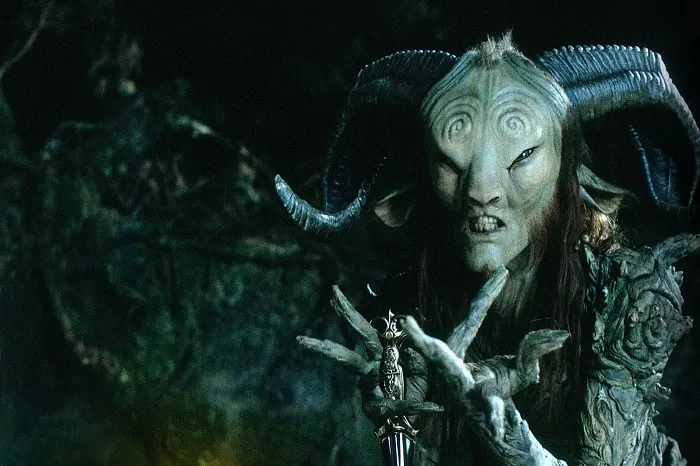Pan’s Labyrinth, directed by Guillermo del Toro, is a 2006 Spanish-Mexican dark fantasy film that blends elements of fairy tale and war drama. Set in Spain in May 1944, five years after the Spanish Civil War, the film tells the story of Ofelia, a young girl who travels with her pregnant mother to live with her new stepfather, Captain Vidal, a sadistic officer in Franco’s army. The movie explores themes of innocence, imagination, and resistance against tyranny.
A Dark Fantasy in Post-War Spain
The film takes place in a rural area where the harsh realities of post-war life are juxtaposed with the fantastical elements of Ofelia’s world. Del Toro uses this setting to highlight the stark contrast between the brutal adult world and the childlike wonder of Ofelia’s experiences. The main point of “Pan’s Labyrinth” can be understood through its exploration of these two worlds and the way they intertwine.
The Central Themes of Pan’s Labyrinth
Ofelia’s Quest for Identity
Ofelia, as the protagonist, embarks on a quest to prove her lineage as the reincarnation of an ancient princess. This journey is both literal and metaphorical, representing her search for identity and belonging in a hostile environment. Through the tasks set by the Faun, she is challenged to confront her fears and maintain her innocence amidst the surrounding chaos.
The Loss of Innocence
The loss of innocence is another significant theme in the film. As Ofelia encounters more of the real world’s horrors, her belief in the magical realm begins to waver. Yet, it is her refusal to abandon her imagination that ultimately defines her character. Her resilience against the oppressive forces around her underscores the importance of holding onto one’s inner
Escaping Reality
Imagination plays a critical role in Ofelia’s ability to cope with the grim reality of her situation. The labyrinth and its inhabitants offer her an escape from the cruelty of the outside world. By immersing herself in this fantasy, Ofelia finds strength and purpose, which helps her endure the hardships inflicted upon her.
Symbolism of the Labyrinth
The labyrinth itself serves as a symbol of the complex path Ofelia must navigate to reach self-discovery. It represents the maze-like nature of growing up and the challenges faced when transitioning from childhood to adulthood. Each turn in the labyrinth presents a new test or revelation about Ofelia’s true self and the world around her.
Oppression Under Fascism
Captain Vidal embodies the fascist regime’s brutality and the oppression it enforces on those under its rule. His actions reflect the wider context of post-war Spain, where dissent was crushed and freedom suppressed. Through Vidal’s character, the film critiques the excesses of power and the dehumanizing effects of totalitarianism.
Acts of Defiance
Resistance against tyranny is shown not only through the guerrilla fighters’ rebellion but also through the individual acts of defiance by characters like Mercedes and Ofelia. These moments of courage serve as reminders of the human spirit’s indomitability and the possibility of change even in the darkest times.
The Cinematic Elements of Pan’s Labyrint
Merging Realities
Guillermo del Toro’s visual style in “Pan’s Labyrinth” is characterized by its rich textures and vibrant colors, creating a dreamlike atmosphere that blurs the line between the real and the imaginary. The director’s use of darkness and light further enhances the mood, emphasizing the dichotomy between the beauty of Ofelia’s fantasies and the bleakness of the war-torn world.
Creatures and Characters
The creatures in the film, such as the Faun and the Pale Man, are meticulously designed to evoke both awe and fear. They embody different aspects of the story’s moral and thematic core, serving as guides and obstacles for Ofelia’s journey. Each creature reflects a part of the human condition, adding depth to the narrative.
Nonlinear Storytelling
The film employs a nonlinear narrative structure, shifting between past and present, reality and fantasy. This approach allows for a deeper exploration of the characters’ psyches and the symbolic meanings behind their actions. The interweaving timelines create a tapestry of stories that enrich the overall meaning of the film.
Symbols and Metaphors
Symbols and metaphors abound in “Pan’s Labyrinth,” offering multiple layers of interpretation. From the mandrake root used to heal Ofelia’s mother to the key that opens the hidden door, each element carries significance that contributes to the film’s central message. The heart of the labyrinth, the chamber with the Pale Man, symbolizes the ultimate test of Ofelia’s resolve and the price of her choices.
Conclusion
At its core, “Pan’s Labyrinth” is a reflection on humanity’s capacity for both cruelty and compassion. It presents a poignant commentary on the impact of war on innocent lives and the resilience of the human spirit. Through Ofelia’s story, the film celebrates the power of imagination as a means of coping with adversity and finding beauty in the midst of despair.
“Pan’s Labyrinth” has left an enduring legacy in cinema for its innovative storytelling, striking visuals, and profound messages. It stands as a testament to Guillermo del Toro’s unique vision and his ability to craft narratives that resonate on a universal level. The film invites viewers to explore the depths of their own imaginations and consider the roles they play in shaping the world around them.
Related topics

